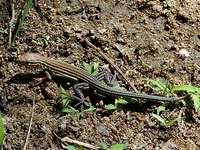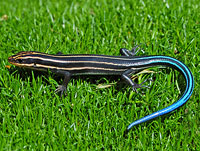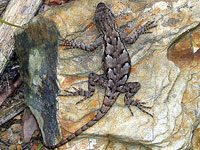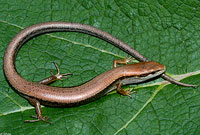 |
|
| |
Discover Nearby Nature: Lizards of Northern Virginia
Written by Alonso Abugattas, Photos © John White
Lizards are the largest group of living reptiles (over 4,000 species world wide). Most lizards look like salamanders (with 4 legs and a tail) but have dry scales, claws on their 5-toed feet, and external ear openings.
Some lizards are also legless and may look like snakes except that they can blink (all Virginia species that lack legs have moveable eyelids) and have external ear openings. Most do not have forked tongues. Only 2 species are venomous (the Beaded Lizard of Mexico and the Gila Monster of the Southwest and Mexico ). The world's largest species is the Komodo Dragon.
There are nine species of native lizards that are found in Virginia, of which six can potentially be found in Northern Virginia. All are species are predatory and lay eggs. Following is a list of these species as well some ways of identifying them.
Since most of these species can shed (autotomize) their tails, traditional snout-to-vent length (SVL) is given first, followed by total maximum length with tail. |
|

|
Eastern Six-lined Race Runner
Sceloporus undulatus
Six light stripes running length of body starting behind eyes. Max SVL 3in (75 mm), total max length 9.5 inches (241 mm). Non-shiny and non-overlapping scales. Fairly long legs.
Very little blue on tails. Tend to stay on the ground and favor hot, sandy areas. Very quick, as the name suggests, taking shelter in burrows or under clumps of grass. Do not autotomize their tails, but some may be incomplete due to near escapes. |

|
Common Five-lined Skink
Plestiodon fasciatus (Formerly Eumeces)
Five narrow, light stripes on a dark background. Max SVL 3.4 inches (86 mm), max total length 8.5 in (215 mm).
Blue tails fade as they mature. Males may lose stripes completely and have reddish heads during the breeding season. Like all skinks, they have short legs and shiny scales. This along with the next 2 species can be difficult to tell apart when young as they all have bright blue tails.
In the hand, this species has larger scales in the middle row along the base of its tail and 4 scales on the upper lip between the nose and eye. (See Virginia Herpetological Society website for example.)
Generally inhabits moist habitats. |

|
Southeastern 5-lined Skink
Plestiodon inexpectatus (Formerly Eumeces)
Five narrow, light stripes on a dark background. Max SVL 3.5 inches (89 mm), max total length 8.5 inches (216 mm).
Blue tails fade as they mature. Mature males' stripes may also fade and they often have reddish head during the breeding season.
May be difficult to tell apart from the 2 other immature Eumeces species in this area. Scales under base of tail all similar in size. Generally found in more sandy, drier habitats than 5-Lined Skink. |

|
Broad-headed Skink
Plestiodon laticeps (Formerly Eumeces)
Five narrow, light stripes on a dark background. Blue tails which fade in adults.Males lose all their stripes and have a broad head (orangish-red during breeding season). Females retain some striping.
Max SVL 5.6 inches (143 mm), max total length 12.8 inches (324 mm). Our largest lizards.
Immatures difficult to distinguish from the 2 preceding lizards. Enlarged middle row of scales under tail and 5 scales along upper lip between the nose and eye (See Virginia Herpetological Society website).
Tend to be arboreal and can give a hard bite. |

|
Eastern Fence Lizard
Sceloporus undulates hyacinthinus
Rough scaled. No stripes. Grayish in color and not shiny. Max SVL <3.4 inches (86 mm), total max length 7.2 inches (184 mm).
Males during breeding season have bright blue or black chins/throats and blue patches on the belly. The only native lizard around here that has rough, keeled scales.
Very likely to climb trees, often keeping the tree trunk between themselves and any potential danger, much like a squirrel. Prefers dry habitats. |

|
Little Brown Skink or Ground Skink
Scincella lateralis
Max SVL 2.2 inches (57 mm), max total length 5.7 in (146 mm). No blue tail. No light stripes on back but a dark one along each side. Shiny, smooth scales.
Our smallest lizard. Has a transparent patch/window in each lower eye lid so it can see even when its eyes are closed. Rarely leaves the ground where it hides in the leaf litter or under grass. |
The other native Virginia species are:
- Eastern Glass Lizard, Ophisaurus ventralis (legless);
- Eastern Slender Glass Lizard, O. attenuatus (legless);
- Northern Coal Skink, Plestiodon anthracinus anthracinus.
Other escapees and released lizards such as iguanas and anoles are occasionally found.
An excellent resource is Joseph C. Mitchell's Reptiles of Virginia. |
|
 |
